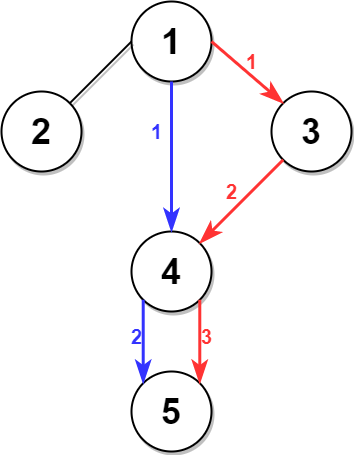Class Solution
java.lang.Object
g2001_2100.s2045_second_minimum_time_to_reach_destination.Solution
2045 - Second Minimum Time to Reach Destination\.
Hard
A city is represented as a **bi-directional connected** graph with `n` vertices where each vertex is labeled from `1` to `n` ( **inclusive** ). The edges in the graph are represented as a 2D integer array `edges`, where each
edges[i] = [ui, vi] denotes a bi-directional edge between vertex ui and vertex vi. Every vertex pair is connected by **at most one** edge, and no vertex has an edge to itself. The time taken to traverse any edge is `time` minutes.
Each vertex has a traffic signal which changes its color from **green** to **red** and vice versa every `change` minutes. All signals change **at the same time**. You can enter a vertex at **any time** , but can leave a vertex **only when the signal is green**. You **cannot wait** at a vertex if the signal is **green**.
The **second minimum value** is defined as the smallest value **strictly larger** than the minimum value.
* For example the second minimum value of `[2, 3, 4]` is `3`, and the second minimum value of `[2, 2, 4]` is `4`.
Given `n`, `edges`, `time`, and `change`, return _the **second minimum time** it will take to go from vertex_ `1` _to vertex_ `n`.
**Notes:**
* You can go through any vertex **any** number of times, **including** `1` and `n`.
* You can assume that when the journey **starts** , all signals have just turned **green**.
**Example 1:**
 
**Input:** n = 5, edges = \[\[1,2],[1,3],[1,4],[3,4],[4,5]], time = 3, change = 5
**Output:** 13
**Explanation:**
The figure on the left shows the given graph.
The blue path in the figure on the right is the minimum time path.
The time taken is:
- Start at 1, time elapsed=0
- 1 -> 4: 3 minutes, time elapsed=3
- 4 -> 5: 3 minutes, time elapsed=6
Hence the minimum time needed is 6 minutes.
The red path shows the path to get the second minimum time.
- Start at 1, time elapsed=0
- 1 -> 3: 3 minutes, time elapsed=3
- 3 -> 4: 3 minutes, time elapsed=6
- Wait at 4 for 4 minutes, time elapsed=10
- 4 -> 5: 3 minutes, time elapsed=13
Hence the second minimum time is 13 minutes.
**Example 2:**

**Input:** n = 2, edges = \[\[1,2]], time = 3, change = 2
**Output:** 11
**Explanation:**
The minimum time path is 1 -> 2 with time = 3 minutes.
The second minimum time path is 1 -> 2 -> 1 -> 2 with time = 11 minutes.
**Constraints:**
* 2 <= n <= 104
* n - 1 <= edges.length <= min(2 * 104, n * (n - 1) / 2)
* `edges[i].length == 2`
* 1 <= ui, vi <= n
* ui != vi
* There are no duplicate edges.
* Each vertex can be reached directly or indirectly from every other vertex.
* 1 <= time, change <= 103-
Constructor Summary
Constructors -
Method Summary
-
Constructor Details
-
Solution
public Solution()
-
-
Method Details
-
secondMinimum
public int secondMinimum(int n, int[][] edges, int time, int change)
-